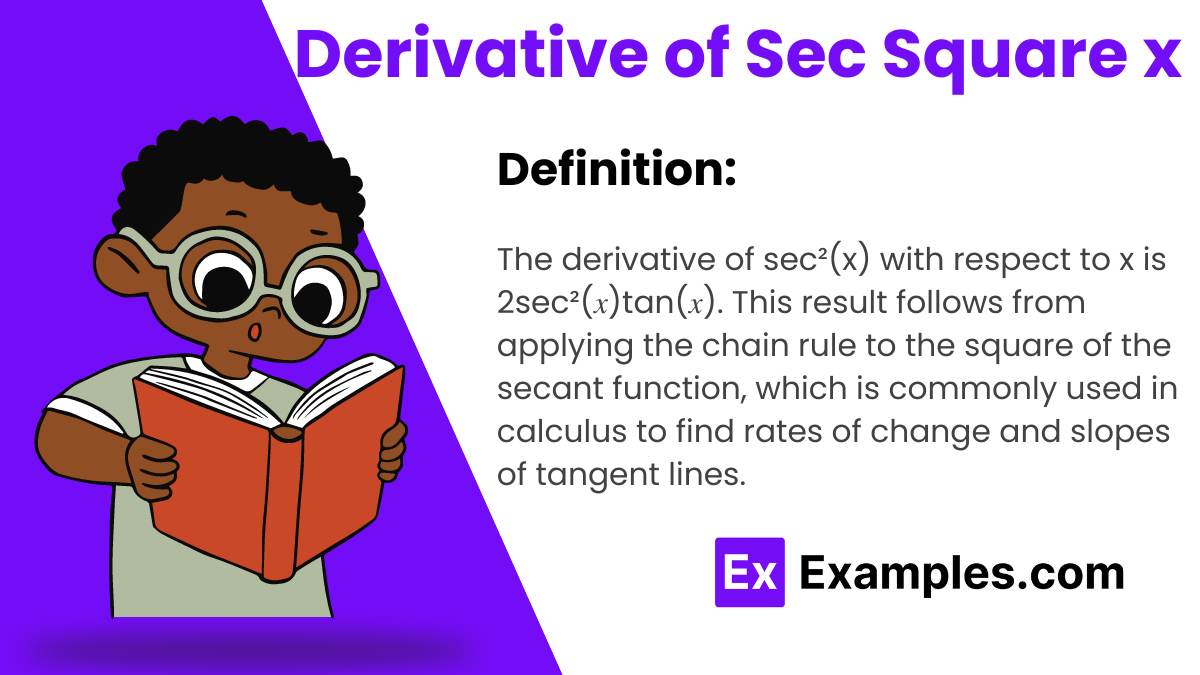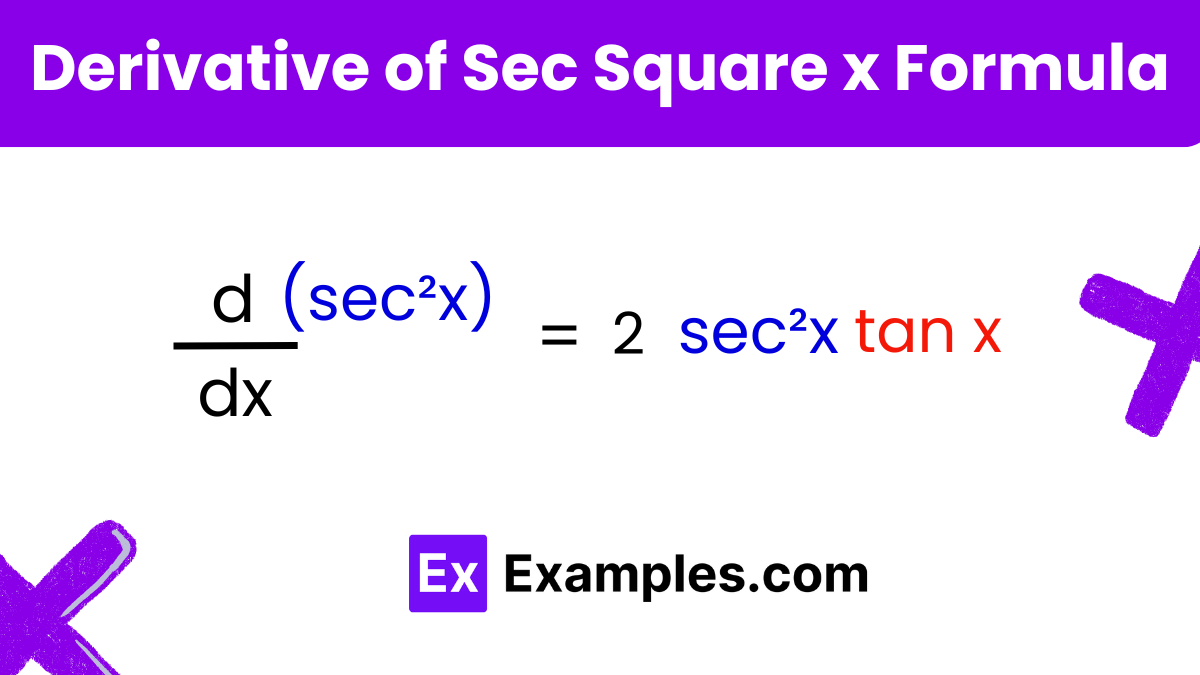What is the derivative of sec²(x with respect to x?
sec(x)tan(x)
2sec(x)tan(x)
2sec²(x)tan(x)
tan²(x)sec(x)


The derivative of sec²(x) is a fundamental concept in calculus, an area of mathematics that deals with changes. Calculating this derivative involves trigonometric functions and their rates of change, integrating concepts from algebra and the behavior of functions. This calculation is essential in various applications, including statistics where it helps in understanding trends and making predictions using methods like the least squares method. The outcome, 2sec²(𝑥)tan(𝑥), reflects how changes in 𝑥 influence the square and square roots of the secant function, connecting deeply with continuous (rational and irrational numbers) and discrete mathematics (integers). Understanding this derivative paves the way for advanced problem-solving in both theoretical and applied mathematics.

The derivative of sec²(x) with respect to 𝑥 is given by the formula:
This result is derived using the chain rule, applying the derivative of sec(𝑥), which is sec(𝑥)tan(𝑥), and then multiplying by the derivative of the outer function 𝑢², where 𝑢 = sec(𝑥).
To find the derivative of sec²(x) using the chain rule, you follow these steps:
𝑑/𝑑𝑥[sec²(𝑥)] = 2sec(𝑥)⋅sec(𝑥)tan(𝑥) = 2sec²(𝑥)tan(𝑥)
To differentiate sec²(x) using the quotient rule, we first recognize that sec(𝑥)=1/cos(𝑥), making sec²(𝑥)=(1/cos(𝑥))².
The quotient rule states that for a function 𝑓(𝑥)=𝑔(𝑥)/ℎ(𝑥), the derivative is given by:
𝑓′(𝑥) = 𝑔′(𝑥)ℎ(𝑥)−𝑔(𝑥)ℎ′(𝑥)/[ℎ(𝑥)]²
Here, 𝑔(𝑥) = 1 and ℎ(𝑥) = cos(𝑥), so 𝑔′(𝑥)=0 and ℎ′(𝑥) = −sin(𝑥). Applying the quotient rule:
(1cos(𝑥))² = 1/cos²(𝑥)
𝑑/𝑑𝑥[1/cos²(𝑥)] = 0⋅cos(𝑥)−1⋅(−sin(𝑥))/cos²(𝑥)
=sin(𝑥)/cos³(𝑥)
Simplifying this, we recognize sin(𝑥)/cos³(𝑥) as sin(𝑥)cos(𝑥)⋅1/cos²(𝑥), which is tan(𝑥)⋅sec²(𝑥). Hence, the derivative is:
tan(𝑥)⋅sec²(𝑥)
To differentiate sec²(x) using the product rule, first express sec²(x) as a product of two functions:
sec²(𝑥) = sec(𝑥)⋅sec(𝑥)
The product rule states that for two functions 𝑓(𝑥)f(x) and 𝑔(𝑥)g(x), the derivative (𝑓𝑔)′ is:
(𝑓𝑔)′=𝑓′𝑔+𝑓𝑔′
Here, both 𝑓(𝑥) and 𝑔(𝑥) are sec(𝑥). Therefore, the derivatives 𝑓′(𝑥) and 𝑔′(𝑥) are sec(𝑥)tan(𝑥), which is the derivative of sec(𝑥).
Applying the product rule:
(sec(𝑥)⋅sec(𝑥))′= sec(𝑥)⋅sec(𝑥)tan(𝑥)+sec(𝑥)⋅sec(𝑥)tan(𝑥)(sec(x)⋅sec(x))′
=sec(𝑥)tan(𝑥)⋅sec(𝑥)+sec(𝑥)tan(𝑥)⋅sec(𝑥)
=2sec(𝑥)tan(𝑥)⋅sec(𝑥)
=2sec²(𝑥)tan(𝑥)
Function: sec²2(x)
Point of Evaluation: 𝑥=𝜋/4
Result: The derivative 𝑑/𝑑𝑥[sec²(𝑥)] at 𝑥 = 𝜋/4 is 4.
Function: sec²(𝑥)
Point of Evaluation: 𝑥 = 𝜋/3
Result: The derivative 𝑑/𝑑𝑥[sec²(𝑥)] at 𝑥 = 𝜋/3 is 8√3.
Function: sec²(x)
Point of Evaluation: 𝑥 = 0
Result: The derivative 𝑑/𝑑𝑥[sec²(𝑥)] at 𝑥 = 0 is 0.
To apply the chain rule, differentiate sec(𝑥) to get sec(𝑥)tan(𝑥) and then multiply this by the derivative of sec(𝑥 raised to the power of two, leading to the result 2sec²(𝑥)tan(𝑥).
This derivative is crucial in fields like physics and engineering, where trigonometric functions model waves, oscillations, and other phenomena. The derivative sec²(x) helps in understanding how these functions change over time or space.
Mastering these concepts aids in tackling more complex problems involving higher-level mathematical theories and applications, such as series expansions and advanced integration techniques.
Text prompt
Add Tone
10 Examples of Public speaking
20 Examples of Gas lighting
What is the derivative of sec²(x) with respect to x?
sec(x)tan(x)
2sec(x)tan(x)
2sec²(x)tan(x)
tan²(x)sec(x)
What is the second derivative of sec²(x)?
2sec³(x)
2sec²(x)(tan²(x)+sec²(x)
2sec³(x)tan(x)
2sec(x)(tan²(x)+sec²(x))
Differentiate f(x) = sec²(x²).
2xsec²(x²)tan(x²)
2xsec(x²)tan(x²)
4xsec(x²)tan(x²)
4xsec²(x²)tan(x²)
Find the derivative of sec²(2x).
2xsec²(2x)tan(2x)
4xsec²(2x)tan(2x)
4xsec(2x)tan(2x)
8xsec(2x)tan(2x)
Find the derivative of \sec^2(x) when x = \frac{\pi}{4}.
1
2
4
4
If y = \sec^2(x), what is \frac{dy}{dx}?
(\sec(x)\tan(x)\)
(2\sec^2(x)\tan(x)\)
(2\sec(x)\tan(x)\)
(\tan^2(x)\sec(x)\)
Calculate the derivative of \sec^2(3x) with respect to x.
(2\sec(3x)\tan(3x)\)
(6\sec^2(3x)\tan(3x)\)
(6\sec(3x)\tan(3x)\)
(2\sec^2(3x)\tan(3x)\)
What is the integral of 2\sec(x)\tan(x)?
(\sec^2(x)\)
(\tan^2(x)\)
(\sec(x)\)
(\sec^2(x) + C\)
What is the derivative of \sec^2(5x)?
(10\sec^2(5x)\tan(5x)\)
(5\sec(5x)\tan(5x)\)
(10\sec(5x)\tan(5x)\)
(5\sec^2(5x)\tan(5x)\)
Compute the derivative of f(x)=sec²sin(x)).
2sec(sin(x))cos(x)
2sec(sin(x))tan(x)
2sec²(sin(x))cos(x)
2sec²(sin(x))tan(sin(x))cos(x)
Before you leave, take our quick quiz to enhance your learning!

